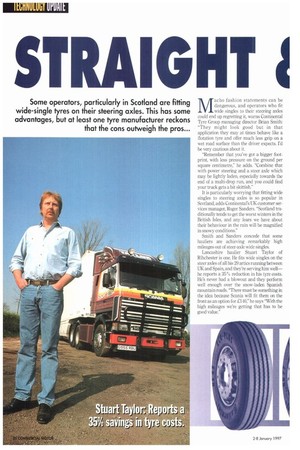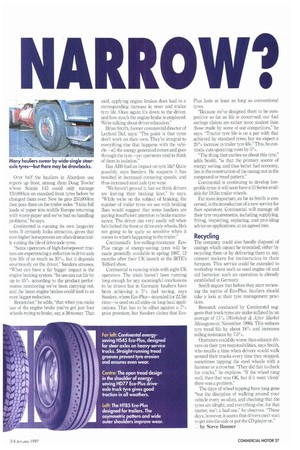S T RAIGHT I NARROW ?
Page 28

Page 29

If you've noticed an error in this article please click here to report it so we can fix it.
Some operators, particularly in Scotland are fitting wide-single iyres on their steering axles. This has some advantages, but at least one tyre manufacturer reckons that the cons outweigh the pros...
Macho fashion statements can be dangerous, and operators who fit wide singles to their steering axles could end up regretting it, warns Continental Tyre Group managing director Brian Smith: "They might look good but in that application they may at times behave like a flotation tyre and offer much less grip on a wet road surface than the driver expects. I'd be very cautious about it.
"Remember that you've got a bigger footprint, with less pressure on the ground per square centimetre," he adds. "Combine that with power steering and a steer axle which may be lightly laden, especially towards the end of a multi.drop run, and you could find your truck gets a bit skittish."
It is particularly worrying that fitting wide singles to steering axles is so popular in Scotland, adds Continental's UK customer services manager, Roger Sanders. "Scotland traditionally tends to get the worst winters in the British isles, and any fears we have about their behaviour in the rain will be magnified in snowy conditions."
Smith and Sanders concede that some hauliers are achieving remarkably high mileages out of steer-axle wide singles.
Lancashire haulier Stuart Taylor of Ribchester is one. He fits wide singles on the steer axles of all his 29 artics running between UK and Spain, and they're serving him well— he reports a 35% reduction in his tyre costs. He's never had a blowout and they perform well enough over the snow-laden Spanish mountain roads. "There must be something in the idea because Scania will fit them on the front as an option for £140," he says "With the high mileages we're getting that has to be good value." Over half the hauliers in Aberdeen use supers up front, among them Doug 'fowler whose Scania 143 could only manage 130,000km on standard front tyres before he changed them over. Now he gets 250,000km then puts them on the trailer axles. "I take full loads of paper into middle Europe returning with waste paper and we've had no handling problems," he says.
Continental is running its own longevity tests. It certainly looks attractive, given that ever-higher horsepowers are often dramatically cutting the life of drive-axle tyres.
"Some operators of high-horsepower tractors are experiencing a reduction in drive axle tyre life of as much as 30%, but it depends enormously on the driver," Sanders stresses. "What can have a far bigger impact is the engine braking system. Its use can cut life by up to 45% according to the product performance monitoring we've been carrying out, and the latest engine brakes could lead to an even bigger reduction.
Remember," he adds, "that when you make use of the engine brake you've got just four wheels trying to brake, say, a 38-tormer. That said, applying engine brakes does lead to a corresponding increase in steer and trailer tyre life. Once again it's down to the driver, and how much the engine brake is employed. We're talking about driver education."
Brian Smith, former commercial director of Leyland Daf, says: "The point is that tyres don't work on their own. They're integral to everything else that happens with the vehicle—all the energy generated comes and goes through the tyre—yet operators tend to think of them in isolation."
I Las ABS had an impact on tyre life? Quite possibly, says Sanders. He suspects it has resulted in increased cornering speeds. and thus increased steer axle tyre wear.
"We haven't proved it, but we think drivers are leaving their braking later," he says. "W bile we're on the subject of braking, the number of trailer tyres we see with braking flats would suggest that some hauliers are paying insufficient attention to brake maintenance. The driver can very easily tell when he's locked the front or drive-axle wheels. He's not going to be quite so sensitive when it comes to what's happening to the trailer."
Continental's low-rolling-resistance EcoPlus range of energy-saving tyres will be made generally available in spring 1997, 12 months after their UK launch at the 1RTE's Telford show.
Continental is running trials with eight UK operators. The trials haven't been running long enough for any meaningful conclusions to be drawn but in Germany hauliers have been achieving a 3"6 fuel saving, says Sanders, where Eco-Plus—intended for 22.3in rims—is used on all axles on long-haul applications. That has to be offset against a 7"0 price premium, but Sanders claims that Eco Plus lasts at least as long as conventional tyres, "Because we've designed them to be cont• petitive so far as life is concerned, our fuel sayings claims are rather more modest than those made by some of our competitors," he says. 'Tractor tyre life is on a par with that achieved by standard tyres, but we expect a 20% increase in trailer tyre life." This, he contends, cuts operating costs by 5° .
"The thing that excites us about this tyre," adds Smith, "is that the primary source of energy saving, and thus better fuel economy, lies in the construction of the casing; not in the compound or tread pattern."
Continental is continuing to develop lowprofile tyres: it will soon have a 55 Series available for 19,5in trailer wheels.
Far more important, as far as Smith is concerned, is the introduction of a new service for fleet operators. Continental will manage all their tyre requirements, including supplying, fitting, inspecting, replacing, and providing advice on applications, at an agreed rate.
Recycling
The company could also handle disposal of casings which cannot be retreaded, either by recycling them or by delivering them to, say, cement makers for incineration in their furnaces. This service could be extended to workshop waste such as used engine oil and old batteries: such an operation is already established in Germany Smith argues that before they start reviewing the merits of Eco-Plus, hauliers should Lake a look at their tyre management practices.
Research conducted by Continental suggests that truck tyres are under-inflated by an average of 15'0 (Workshop & After Market Management, November 1996). This reduces tyre tread life by about 18% and increases rolling resistance by 7.5'D.
Operators could do worse than educate drivers on their tyre responsibilities, says Smith, who recalls a time when drivers would walk around their trucks every time they stopped, sometimes tapping the steel wheels with a hammer or a crowbar. "They did that to check for cracks," he explains. "If the wheel rang well, then that was OK, but if it went 'clonk' there was a problem."
The clays of wheel tapping have long gone "but the discipline of walking around your vehicle every so often, and checking that the Lyres are alright. and everything else, for that matter, isn't a bad one," he observes. "These days, however, it seems that drivers can't wait to get into the cafe or put the CD player on."
by Steve Banner
















































































